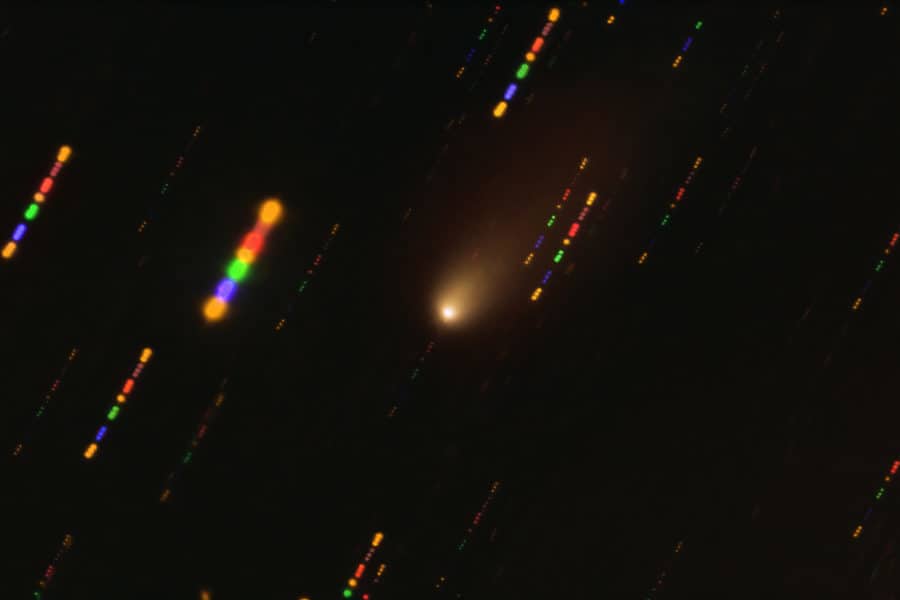A team of scientists, including a researcher with the University of Central Florida and Arecibo Observatory, has discovered that a rare, interstellar comet may be one of the most pristine objects ever documented to have visited our solar system.
Such a “pristine” interstellar comet, or one that has never passed near a sun, is of interest to scientists because it could offer insight into the material makeup of a solar system different than ours. The results were published recently in the journal Nature Communications.
Comets are icy, dusty objects passing through space that are thought to contain the earliest building blocks of solar systems. A pristine comet would have the purest sample of these building blocks, as it would never have been affected by solar wind and radiation.
Many comets in our solar system originate from the Oort Cloud far past Pluto, but the comet the researchers examined, Comet 2I/Borisov, is from another solar system and is the first documented comet to arrive from interstellar space.
The combination of pristine and interstellar traits makes Comet 2I/Borisov incredibly special, says study co-author Maxime Devogele, an observatory scientist at the Arecibo Observatory, which is managed by UCF for the National Science Foundation under a cooperative agreement.
The scientists discovered the comet’s pristine quality by examining the light scattered by its dust particles and finding the light was highly polarized, and thus very pristine. This was the first time this technique, known as polarimetry, has been applied to an interstellar comet, Devogele says.
The work was not done at Arecibo, but Devogele is part of a team of experts observing comets and asteroids in polarimetry.
Comet 2I/Borisov was discovered in 2019 by Gennadiy Borisov using an observatory in Crimea. Previous research using spectral analyses had found Comet 2I/Borisov to be similar to comets from our solar system.
However, the polarimetric analysis revealed that it was quite distinct, Devogele says.
The only comet with comparable polarimetric results was Hale–Bopp, which was one of the most pristine comets ever observed, Devogele says.
Hale–Bopp is believed to have approached our Sun only once before its apparition in 1997, according to the study. Hale-Bopp is thought to be from the Oort Cloud.
“Due to the polarimetric similarities with Hale-Bopp and the interstellar origin of Borisov, this comet has probably never passed close to another star before and is the most pristine object ever observed,” Devogele says.
Comet 2I/Borisov is only the second recognized small body entering our solar system from interstellar space. The first was the space object Oumuamua in 2017.
The researchers made their observations of Comet 2I/Borisov from 2019 to 2020 using the European Southern Observatory’s Very Large Telescope in Chile as the comet passed through our solar system.
The comet is now too far away to be observed, but researchers continue to observe other comets and look for interstellar ones in their search for clues to how our solar system and others formed. Future science missions may even be able to one day intercept interstellar comets.
“We all felt very excited when we saw that Borisov did not look like any other comet in our solar system, except for Hale-Bopp,” Devogele says. “The strong similarities with Hale-Bopp show that they both formed in an alike environment even if they come from different star systems.”
Study co-authors were lead author Stefano Bagnulo with Armagh Observatory and Planetarium in the United Kingdom; Alberto Cellino with Osservatorio Astrofisico di Torino in Italy; Ludmilla Kolokolova with the University of Maryland; Rok Nezic with Armagh Observatory and Planetarium, Mullard Space Science Laboratory in the United Kingdom, and the Centre for Planetary Science in the United Kingdom; Antonio Santana-Ros with Universidad de Alicante in Spain and Universitat de Barcelona in Spain; Gennadiy Borisov with Armagh Observatory and Planetarium and Bulgarian Academy of Sciences in Bulgaria; Apostolos Christou with Armagh Observatory and Planetarium; and Philippe Bendjoyawith University of Côte d’Azur in France.
Devogele received his doctorate in planetary sciences from Liège University in Belgium and the University Côte d’Azur in Nice, France. He joined UCF as an observatory scientist at Arecibo Observatory in 2020.

